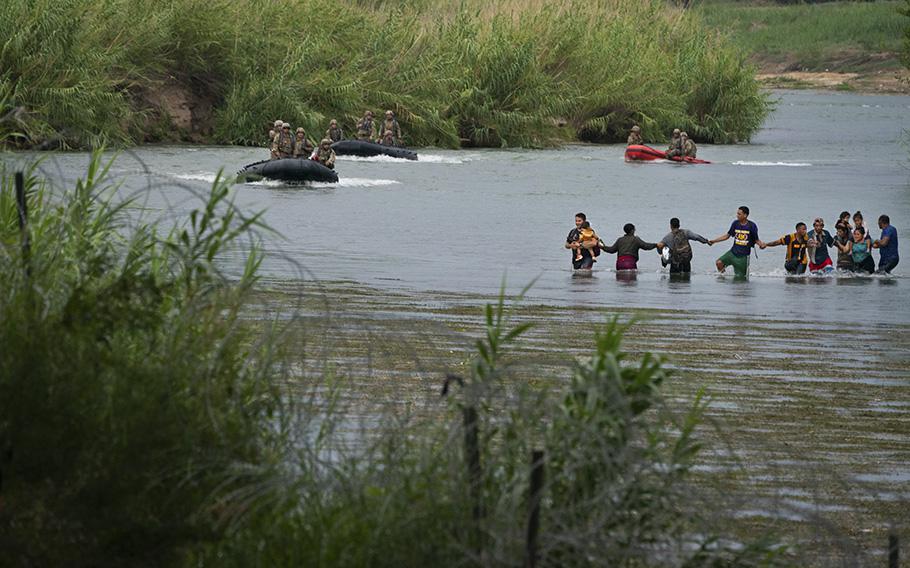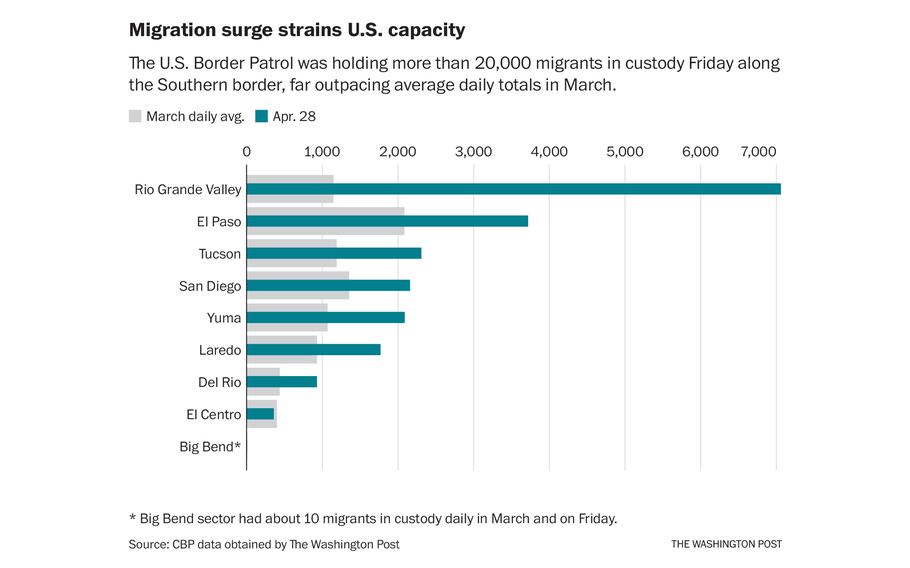Americas
New surge of migrants strains US capacity ahead of May 11 deadline
Special to The Washington Post April 29, 2023

Migrants join hands as they wade across the Rio Grande near the Eagle Pass-Piedras Negras International Bridge on August 12, 2022 in Eagle Pass, Texas, as National Guard members look on. (Sarah L. Voisin/Washington Post)
EL PASO — A new migration surge has stretched U.S. Border Patrol stations and holding cells beyond capacity just two weeks ahead of the day the Biden administration plans to lift pandemic-era health restrictions, projecting an even larger influx.
More than 20,000 migrants were in Border Patrol custody Friday morning, more than twice the rated capacity of the agency's detention facilities along the southern border, according to data obtained by The Washington Post. About 7,000 migrants are currently being held in the Rio Grande Valley of South Texas, the most overcrowded Customs and Border Protection sector.
Much of the latest surge has been driven by thousands of Venezuelan adults and children crossing the river into Texas in recent days by wading, swimming and cramming into smugglers' rafts.
"I never expected we'd be in this position here in Eagle Pass," Maverick County Sheriff Tom Schmerber said in an interview. "We can't stop it."
U.S. agents have recorded more than 8,000 migrant apprehensions along the southern border on some days this week, and officials say illegal crossings are expected to surpass 10,000 per day after May 11, the date the White House is planning to lift the emergency public health restrictions known as Title 42 that have been in place since March 2020.
When the volume of border crossings has overwhelmed authorities in recent years, they have resorted to providing migrants with instructions to report to immigration offices in U.S. cities. The mass releases of apprehended migrants are widely viewed as an incentive to additional illegal entries.
Some municipal leaders such as New York Mayor Eric Adams, D-N.Y., have said they can no longer handle the arrival of so many migrants from the border who need shelter and assistance.

()
Biden officials are anxious to avoid the kind of chaos they faced in Del Rio, Texas, in 2021 when thousands of mostly-Haitian migrants forded the Rio Grande to set up a makeshift camp that created a humanitarian emergency.
Homeland Security Secretary Alejandro Mayorkas told reporters this week the Biden administration has had 18 months to prepare for Title 42's end, anticipating illegal crossings will rise because "smugglers are seeking to take advantage of this change and already are hard at work spreading disinformation that the border will be open."
"The smugglers' propaganda is false," he said firmly. "Let me be clear: our border is not open and will not be open after May 11th."
The Title 42 measures have allowed U.S. authorities to rapidly expel migrants to their home countries or back to Mexico without giving them a chance to seek asylum. The government has used the restrictions to make more than 2.6 million expulsions over the past three years, CBP data show. But roughly the same number have been exempted from the policy, often allowed in the United States with pending claims for asylum or another form of humanitarian refuge.
Troy Miller, the acting CBP commissioner, told a congressional subcommittee last week that his agency has holding capacity for about 8,500 migrants along the Mexico border.
The government is currently spending $991 million per year on emergency "soft-sided" facilities, he said, referring to the large air-conditioned tents where CBP can detain migrants for processing when holding cells inside Border Patrol stations are maxed out.
A Government Accountability Office report last year criticized border officials for failing to coordinate migrant releases with U.S. Immigration and Customs Enforcement, after lines stretching for hours or days formed outside ICE processing centers. The agency's New York City office is so backlogged that migrants have been issued appointments into the year 2033.
Mayorkas and other Biden officials say they plan to respond to the influx after the policy ends by ramping up deportations and imposing the kind of legal consequences - including the threat of criminal prosecution - whose use was limited by the Title 42 process.
Venezuelan migrants are among the most challenging for the Homeland Security officials, because deportations are severely limited as a result of U.S. tensions with the government of President Nicolás Maduro. More than 7 million Venezuelans - nearly a quarter of the country's population - have left their homeland during the past decade of Maduro's rule, according to U.N. estimates.
Most have resettled in South America, but record numbers have been hiking through the Darien Gap jungle region between Colombia and Panama. The Biden administration has deployed CBP advisers to work with Panamanian and Colombian authorities on a 60-day campaign to turn migrants back.
CBP reported a 25 percent jump in unlawful crossings from February to March, attributing the increase to historic seasonal trends, while noting Border Patrol arrests were lower overall last month compared to March 2022. But for U.S. officials tracking border trends, the CBP daily in-custody numbers are a key indicator of the government's ability to cope with migration pressures.
In December, when CBP reported more than 252,000 border encounters, the highest total ever, the average number of migrants held per day in Border Patrol custody was 12,377, statistics show.
The daily average dropped to 4,847 in January, the month U.S. officials implemented new control measures through a deal with the Mexican government, allowing U.S. authorities to send up to 30,000 migrants from Cuba, Haiti, Nicaragua and Venezuela back across the border.
Biden officials touted the agreement and their expansion of legal opportunities for migrants to live and work in the United States as the best formula for managing the border, pointing to a decline of more than 90 percent in the number of migrants from the four nations attempting to enter illegally.
But after a deadly fire last month at an immigration detention facility in the border city of Ciudad Juárez, the Mexican government put new limits on U.S. ability to return Venezuelans.
Migrants in Ciudad Juárez said this week they are desperate to leave Mexico and frustrated with the limited opportunities offered by the United States for legal entry.
"I think now is the time," said Haidelys Aguilera, a 29-year-old Venezuelan waiting near the riverbank.
Aguilera said she had registered her family with a U.S. mobile app for migrants seeking to enter the United States legally, but she was growing impatient. That afternoon, her 2-year-old son had wandered off, and a frenzy of screams from nearby motorists alerted his father that the boy had walked into the street. A bus screeched to a halt to avoid the child.
Angel Antonio Graterol Garces, a 41-year-old Venezuelan, said he was motivated to cross now, before Title 42 expires, and he could face harsher consequences for arriving illegally.
"That makes us criminals, just people looking for a better life," he said. "We become animals who are being chased."
Graterol was staying in a migrant camp set up outside the charred former Mexican detention center where 40 were killed in the March 27 fire.
About 100 tents lined the street leading to the building, and memorials for the victims were draped from a perimeter fence. Most of the migrants in the camp were also from Venezuela, and said they were awaiting Title 42's end for a chance to enter the United States.
Some migrants believe that when the policy ends, U.S. border enforcement will be suspended, according to Graterol, repeating the kind of false rumor Biden officials have been trying to dispel.
"We're not using the app, it does not work at all anyways," he said, referring to the mobile app, CBP One. "If it worked, do you think we would all be here, just sitting like this?" He gestured to the rows of tents lining the street.
Other migrants in Ciudad Juárez said the city's police have forced them away from the downtown area, and U.S. border agents shouting from across the river told them to walk eastward toward a designated spot for migrants seeking asylum.
This area is known as "door number 40" - a section of the border wall with large gates that open into the United States. A crowd of about 50 migrants gathered there on a recent afternoon along the border wall, waiting for a Border Patrol van to pick them up.
The crossings into residential neighborhoods have heightened tensions in El Paso.
Henry Candelaria, who lives about a mile from door number 40, told U.S. officials meeting with El Paso residents this week that the situation was out of control.
Candelaria said he was preparing his morning coffee on a recent Sunday when he saw a man in his backyard and confronted him. The man jumped the fence in a neighbor's yard, but the neighbor's dogs chased him back.
"As soon as he jumped over, I took him down, and both me and my daughter pinned him to the ground. We put a chokehold on him," said Candelaria, adding that he told the man: "You'd better settle down because we have a gun."
"The guy saw we were loaded and he thought about it and stopped fighting," Candelaria said.
Texas State Troopers and Border Patrol agents arrived, he said, and took the man into custody.
Miroff reported from Washington. Arelis R. Hernández in San Antonio contributed to this report.